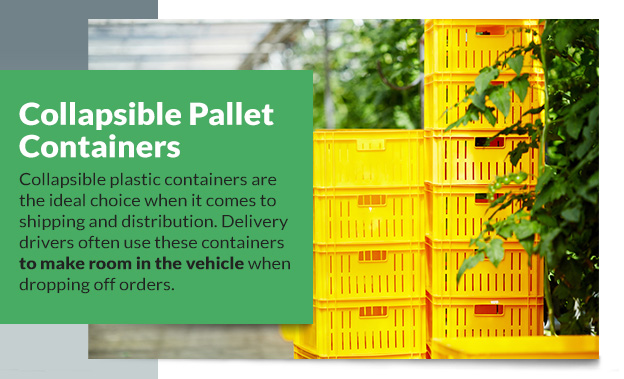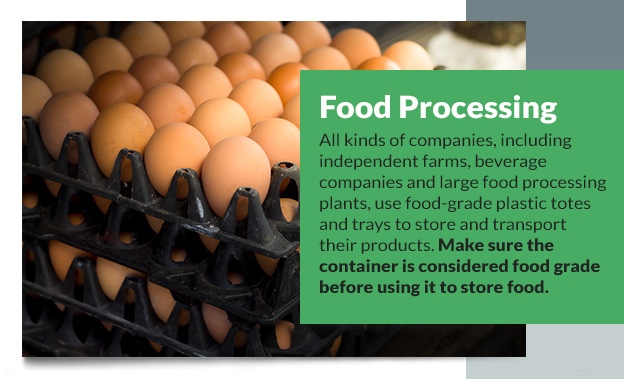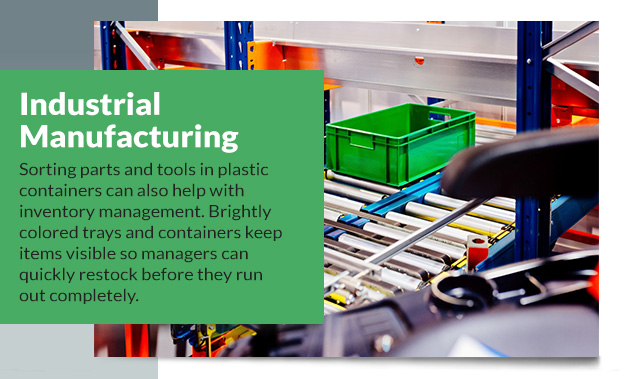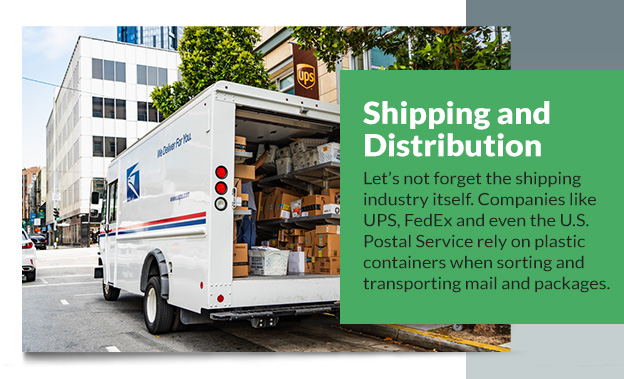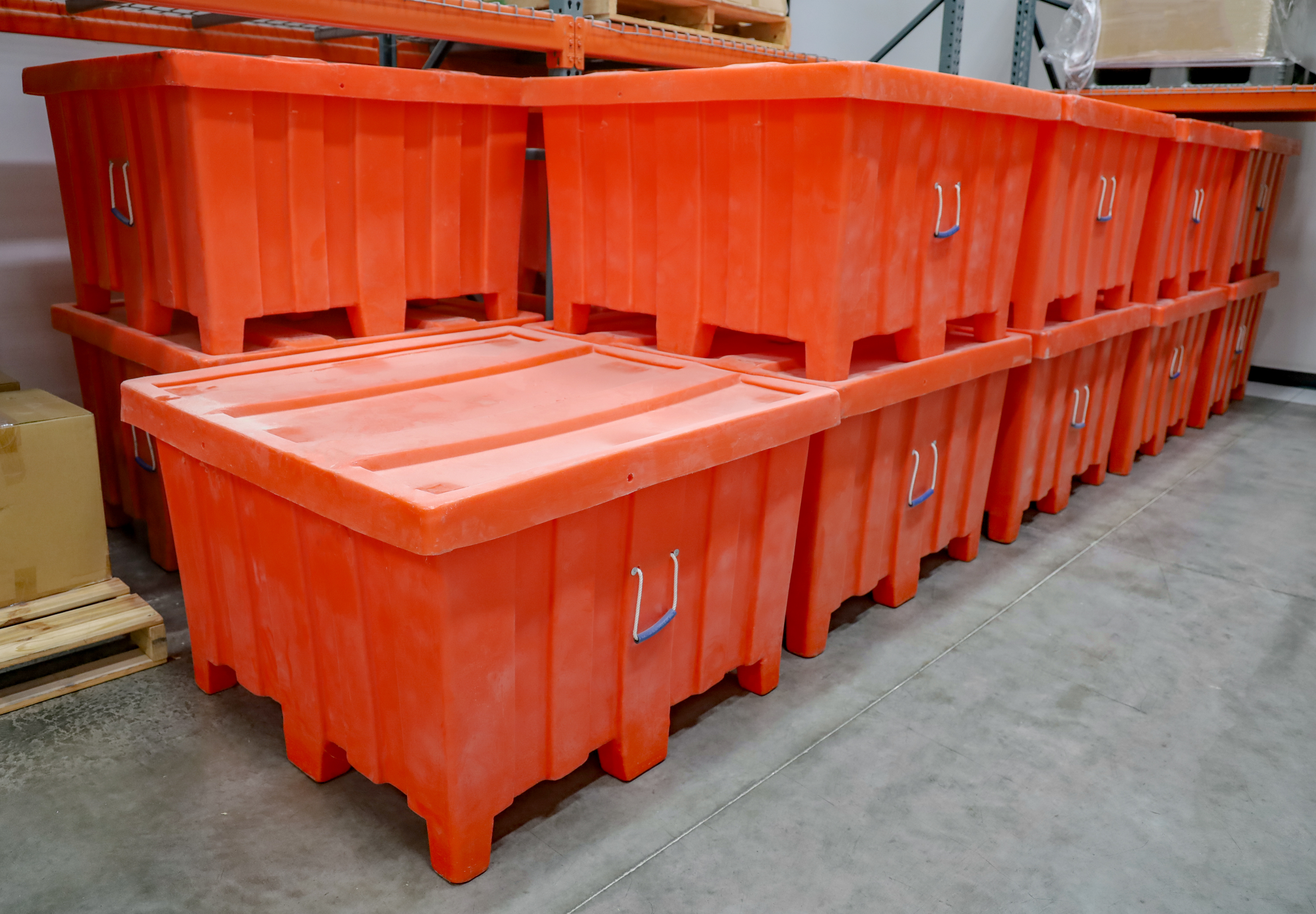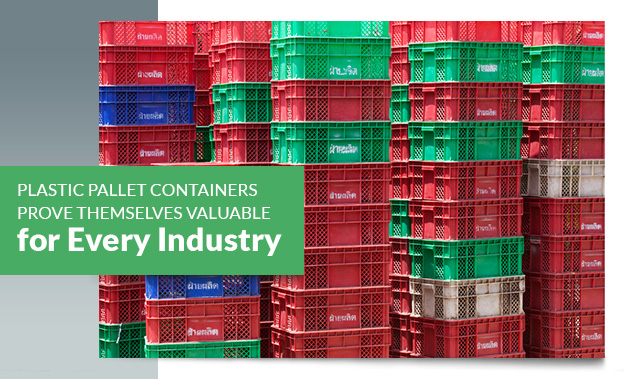
Plastic containers are used to store and transport nearly every type of product imaginable. From consumer goods to food and beverages, there’s a good chance plastic was used at some point in the manufacturing or distribution process. The U.S. Environmental Protection Agency estimates that around 14.5 million tons of plastic containers and packaging were generated in 2017, the most recent year this data is available.
There are several reasons so many different industries use plastic containers. They are much lighter than other types of shipping containers, including those made of steel, glass and metal, which helps companies save money on shipping. Yet, they have the wherewithal to withstand everyday wear and tear. They are much sturdier than cardboard boxes and disposable shipping containers, so companies don’t have to put their products at risk.
Plastic containers are used for more than just shipping merchandise. Companies also use them to organize their inventory, simplify the manufacturing process and maintain warehouse efficiency. If you’re looking for a better way to store and transport your goods, learn why plastic containers are so valuable.
SHOP PLASTIC PALLET CONTAINERS
How Different Industries Use Plastic Containers
- Automotive
The next time you buy or drive a car, think of all the plastic containers that were used to make the vehicle. You can’t fit a car inside a plastic container, but they come in handy throughout the manufacturing process. Cars are made up of tens of thousands of different parts and keeping all these individual items organized can be a challenge in many warehouse settings.
While many auto manufacturers rely on automation, they need to make sure they have spare parts available when fixing and designing their vehicles. Many different facilities will use plastic containers to separate individual parts on the shelf, including everything from screws and nuts to exhaust filters, tools and shocks.
Warehouse workers need to access these parts quickly when working on and building various vehicles. Many of these parts look similar but they have slight differences. Workers will label these containers to make sure they are grabbing the right part. They can focus on the task at hand without second-guessing themselves when sorting through different containers. This improves efficiency throughout the workplace. It also increases the chances that workers return equipment and tools to the right containers.
Plastic containers come in many different sizes and styles. Automotive manufacturers may use large plastic bins to hold heavier items and smaller totes and trays for organizing screws and bolts. Facilities can also color-coordinate their containers by category or department to further reduce confusion when picking individual parts.
- Food Processing
So many different types of foods pass through various plastic containers on their way to the consumer. All kinds of companies, including independent farms, beverage companies and large food processing plants, use food-grade plastic totes and trays to store and transport their products. These kinds of containers are usually made with PET, HDPE, PVC or LDPE plastics. Make sure the container is considered food grade before using it to store food. If the container has been used to store or transport food in the past, it is usually safe to use it for food again.
Plastic is much more reliable than cardboard when it comes to shipping and protecting food products. These items are considered extremely sensitive, so companies need to take special precautions when shipping their products to various retail outlets.
These containers are also waterproof, so companies don’t have to worry about their products getting soggy during transit, which is particularly important when it comes to shipping baked goods and produce. They can also be used to store temperature-sensitive products, including frozen and refrigerated products, without absorbing any condensation.
You will often find plastic trays in bakeries and other food processing plants. If the product needs to cool before moving on to the consumer or the next stage in the manufacturing process, companies can use bakery trays and ventilated containers to protect these items until they reach the proper temperature.
- Industrial Manufacturing
Like the automotive industry, industrial manufacturing plants need to keep track of hundreds, if not thousands, of individual items. These companies produce everything from cleaning equipment to furniture, various types of machines and home appliances. Each item is made up of dozens of different parts, including screws, nuts, bolts, bands, rods and gears.
These companies will use plastic totes and bins to organize their inventory, which improves efficiency throughout the manufacturing process. Workers can retrieve individual parts and tools in mere seconds when building or fixing various products and equipment.
Sorting parts and tools in plastic containers can also help with inventory management. Brightly colored trays and containers keep items visible so managers can quickly restock before they run out completely.
- Pharmaceuticals
When it comes to shipping and storage, nothing could be more sensitive than pharmaceuticals. These items are meant for human consumption, so even the slightest error could carry dangerous consequences. Pharmaceutical manufacturers will use plastic containers to ship their products to medical facilities and healthcare providers. Plastic has the durability to keep these goods safe during transit. They are also reusable. This ensures that manufacturers and care providers do not have to worry about recycling or ordering more storage materials.
Pills and pill containers are also similar in size and appearance. Pharmacists and manufacturers often need to sort through dozens of different products and items when fulfilling orders and prescriptions. Plastic trays and totes keep these items accessible in the workplace. Workers can reach right into the container and retrieve the right number of pills without messing with lids.
- Shipping and Distribution
Let’s not forget the shipping industry itself. Companies like UPS, FedEx and even the U.S. Postal Service rely on plastic containers when sorting and transporting mail and packages. Plastic totes are light in weight and easy to handle, so these workers don’t have to overexert themselves on the job. Workers will often label individual trays and bins to simplify the retrieval process. They may order pieces of mail alphabetically, by address or zip code.
Workers often have to make sense of hundreds of individual residents and addresses in a single day. In fact, the Postal Service alone processes and delivers 472.1 million mail pieces each day. Plastic totes and trays make this work easier so employees don’t lose track of important items.
- Retail
Just about every type of store will use plastic containers at some point. From mom and pop grocery and hardware stores to massive retail outlets, plastic containers make it easy to move and store merchandise.
Retail workers will often sort incoming items in plastic totes and containers as they distribute them throughout the store. They will also use totes and trays to organize important tools and equipment on the job. Loading docks, storage facilities and unpacking rooms tend to be filled with different kinds of plastic containers.
Some plastic containers are stackable and collapsible, which can prove useful when it comes to unpacking and moving merchandise. Workers can quickly stack full containers on top of each other as they wheel them through the store. This makes it easy to move large quantities of goods at once. It also clears up space in the workplace so employees aren’t stepping on each other’s toes.
Workers can also collapse these containers when they are not in use to make more room on the job. The same goes for delivery personnel. Drivers can quickly condense their inventory as they deliver goods throughout the day.
The Many Varieties of Plastic Pallet Containers
Now that you understand the many uses of plastic bulk containers, let’s dive into the different types of plastic totes and their benefits.
- Solid Wall
Solid wall plastic containers are perfect for keeping debris and moisture at bay. Some of these containers come with doors or lids that make it easy to seal off the contents. This is often a good choice if you need to ship and store sensitive merchandise, such as pharmaceuticals, baked goods and items that are susceptible to moisture.
You may also choose solid wall containers if you need to store or organize loose items that would otherwise fall through the cracks. They are perfect for storing bolts, screws, nuts, buttons, chips, gears and other small parts. Go with smaller plastic trays and totes to reduce the amount of empty space.
- Ventilated
Ventilated containers are the exact opposite of those with solid walls. These containers feature mesh walls so air can reach the inside. This is helpful if you need to let your products breathe during transport or storage. You can also use bakery trays and totes to let your product cool down before transport.
They are also perfect for harvesting produce. Instead of mashing fruits and vegetables into a solid wall container, the ventilation gives these items more room to spread out. They come with handles on each side, which makes it easier to move around. Your team can load and unload the delivery vehicle in less time.
You can also stack these totes and crates on top of each to condense space without putting your goods in harm’s way. Ventilated containers also keep your items visible–you can see exactly what you’re dealing with. You can identify the contents when stacking and delivering these containers to the consumer, which reduces confusion on the job.
You might also want to keep your goods visible when picking items off the shelf. Warehouse workers can quickly identify the contents of the container in addition to reading the label. This improves accuracy and efficiency during the picking process so you can fulfill orders in record time while reducing the number of returns.
- Collapsible Pallet Containers
Collapsible plastic containers are the ideal choice when it comes to shipping and distribution. Delivery drivers often use these containers to make room in the vehicle when dropping off orders. This makes it easier for the driver to access the contents of the truck. If the back is filled with empty upright containers, they may have trouble finding what they need.
SHOP COLLAPSIBLE PLASTIC PALLET CONTAINERS
You can easily stack these containers once they’ve been collapsed. You and your team will have more room to spread out when completing various tasks in the loading dock or warehouse. Collapsing containers is also about employee safety. Your workers should have the freedom to move around without worrying about tripping over empty totes and trays.
This will also improve the cleanliness of your facility. Your team will be able to reach areas that might otherwise go untouched. If an item goes missing, you don’t have to search through a bunch of empty containers.
- Non-Collapsible Containers
Non-collapsible containers have their benefits, too. They are a great choice when it comes to storing inventory on the shelf. Some totes and trays will stay put on the shelf for years on end, so it’s best to keep them upright, even if they don’t have anything inside. This will help you stay on top of your inventory. If you run out of certain items, you shouldn’t collapse the container. Keep it empty as a reminder that you need to place another order.
At the end of the day, it’s best to buy rigid plastic containers if you don’t need to condense your storage materials. Having a collapsible container may be more trouble than it’s worth if your team collapses these containers by accident.
Choosing the right style of pallet containers all depends on the needs of your business. Keep this information in mind as you compare different types. Each style comes with its own pros and cons. It’s just about knowing what’s best for your employees. Think about the day-to-day operations of your business and how your employees navigate the space before using collapsible pallet containers in your warehouse.
